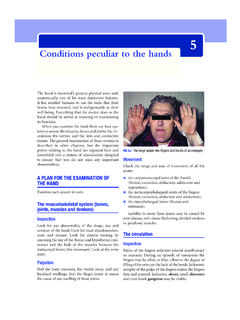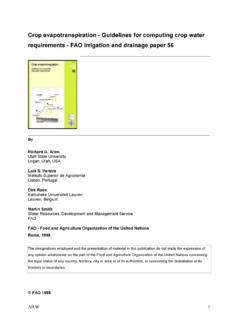Transcription of Thermodynamics worked examples - Taylor & Francis
1 An Introduction to Mechanical Engineering Part 1. Thermodynamics worked examples 1. What is the absolute pressure, in SI units, of a fluid at a gauge pressure of bar if atmospheric pressure is bar? Solution Absolute pressure = p = pg + pa = + = bar = 251 kPa o 2. Convert -25 C to a temperature in degrees Kelvin. Solution o T[K] = T[ C] + = -25+ = 3. Calculate the following: (i) the kinetic energy of a body which has a mass of 5 kg and a velocity of 10m/s;. (ii) the change in potential energy of a mass of 5 kg when it is raised a height of 3m;. (iii) the strain energy stored in a spring compressed by 18mm from its free length if the spring constant is MN/m;. (iv) the increase in internal energy of a gas in a closed system during a process in which -100 J of heat transfer and 400 J of work transfer take place.
2 Solution 1 1. (i) Kinetic energy = = mc 2 = 5 100 = 250J. 2 2. (ii) Change in potential energy = mg z = 5 3 = 147J. 1 2. (iii) Strain energy stored = kx 2. 1. = 10 6 2 = 243 J. 2. (iv) Increase in internal energy = U2 U1. First Law: W+Q = U2 U1 = 400 -100 = 300J. Hodder Education 2009. An Introduction to Mechanical Engineering Part 1. 4. The piston in Figure has no mass and is free to move. The point force F acting on the piston is applied gently so that the piston moves slowly to the left. As the gas in the cylinder is compressed, the product of pressure and system volume, pV, remains 2 3. constant. The piston area is m and when x is x1 the system volume is . Atmospheric pressure is 1 bar.
3 Calculate the distance (x2-x1) moved by the piston as F. increases from 0 to 70N. Solution Equilibrium of forces on piston: p2A = 70 + paA. 70. + 10 5. p2 = = x 105 Pa Given pV = constant p1 V1 = p2 V2. p1V1 10 5 V2 = = 10 5 = 3. p2 10 5. x2 x1. Distance moved by piston: l2. l1. x 2 x1 = l 1 l 2. V1 V2. = V2. A. = = or 5. Calculate the work input to the closed system undergoing the cycle shown in Figure if the pressure during process (2) to (3) is raised from 1000 kPa to 1400 kPa. Solution 3 2. 1400. kPa P. 4 1. 200. kPa 3 3. Hodder Education 2009. An Introduction to Mechanical Engineering Part 1. W net = W 12 + W 23 + W 34 + W 41. 5 5. = 0 + 14 x 10 ( ) + 0 + 2 x 10 ( ). 5 5. = -7 x 10 + 1 x 10 = -600kJ.
4 6. (i) Calculate the efficiency of a reversible heat engine operating between a hot reservoir at 900K and a cold reservoir at 500K. (ii) The temperature of one of the heat reservoirs can be changed by 100 degrees kelvin up or down. What is the highest efficiency that can be achieved by making this temperature change? Solution T2 500. (i) = 1 = 1 = T1 900. T2. (ii) The largest reduction in is produced by subtracting the temperature change from the T1. lower temperature. 400. = 1 = 900. 7. A perfect gas at a pressure of 58 bar and a temperature of 450K has a density of 50. kg/m . The ratio of specific heats is 3. (i) Calculate the values of molar mass m ~ , specific heat at constant pressure c and p specific heat at constant volume cv.
5 (ii) Calculate the change in specific entropy of the gas if the pressure is raised to 100. bar and the temperature is lowered to 400K. Solution p (i) Perfect gas, = RT .. p 58 10 5. R= = = 257 .77J / kgK. T 50 450. ~ 3. ~ = R = 10 = 322 .5kg / kmol m R R cp = = 257 .77 = 794 .79J / kgK. 1 Hodder Education 2009. An Introduction to Mechanical Engineering Part 1. R 257 .77. cv = = = / kgK. 1 (ii) Specific entropy change T2 p s 2 s1 = cp l n R ln 2. T1 p1. 400 100 . = n 257 .8l n . 450 58 . = 8. Calculate the dryness fraction x of saturated steam if it has a specific enthalpy of 800. kJ/kg and at the same pressure and temperature, the specific enthalpy of saturated liquid is 505 kJ/kg and the latent heat of vaporization is 2202 kJ/kg.
6 Solution h = hf + xhfg h hf 800 505. x= = = hfg 2202. 9. A perfect gas with a value of undergoes an expansion process from a pressure of 600 kPa. The ratio of specific volumes v2/v1 is Calculate the pressure p2 at the end of the process if this is (i) polytropic with an index n of , (ii) isothermal, (iii) isentropic. Solution n p2 v 2 . (i) = . p1 v 1 . p2 = 600 10 3 (3 ) = 103 .4kPa (ii) pv = RT pv = constant v . p2 = 600 10 3 1 = 200kPa v2 .. p2 v 2 . (iii) = . p1 v 1 . p 2 = 600 10 3 x(3 ) = 128 .9kPa Hodder Education 2009. An Introduction to Mechanical Engineering Part 1. 10. A perfect gas with a value of can be compressed in either a non-flow or a steady flow process between the same initial and final states.
7 Neglecting any change in kinetic and potential energy, what is the ratio of the specific work done is the two cases if the process is (i) polytropic with an index n of ;. (ii) isothermal;. (iii) isentropic? Solution Refer to results given in Table w flow . Ratio is: . w non flow . (i) (ii) 1. (iii) 11. Calculate the efficiency of the following ideal cycles when undergone by a perfect gas with a value of : (i) a Stirling cycle operating between a hot reservoir at 600K and a cold reservoir at 300K;. (ii) a Brayton cycle with a pressure ratio of 8;. (iii) an Otto cycle with a compression ratio of 8;. (iv) a Diesel cycle with a compression ratio of 12 and a cut-off ratio of 2. Solution T2.
8 (i) = carnot = 1 . T1. = 50%. 1 1. (ii) = 1 ( 1) = 1 8 / pr = 1 1. (iii) = 1 ( 1) = 1 8 cr = 1 c 0 1 . (iv) = 1 . c r ( 1) (c 0 1) . Hodder Education 2009. An Introduction to Mechanical Engineering Part 1. = 1 . (2 1 ). 12 ( 1). = 3. 12. A perfectly insulated, rigid tank with a volume of m contains a perfect gas which has a molar mass of 18 kg/mol and a ration of specific heats of Initially the pressure and temperature in the tank are 9 bar and 320 K respectively. A fan inside the tank is spun at 3600 rev/min for 20 seconds. The torque required to turn the fan is 30 Nm. Calculate the following: (a) The R, cp and cv values of the gas and the mass of gas in the tank. (b) The work input (given by torque x angular rotation in radians) to the gas from the fan.
9 (c) The final temperature of the gas. (Explain briefly why the temperature continues to rise for a short time after the fan has stopped rotating.). (d) The increase in entropy of the gas. Solution V = 3. = ~ = 18kg / kmol m T1 = 320K. P1 = 9bar Torque = 30 Nm 3600. N = 3600 rev / min = = 60 rev / s 60. ~. R 8314 .5J / kmolK. (a) R = ~ = = 462J / kgK. m 18kg / kmol R Cp Cv = = 1 = Cv Cv Cv C v = / kg / K. Cp = C v = / K. Hodder Education 2009. An Introduction to Mechanical Engineering Part 1. P1 V1 9 10 5 m= = = RT1 (b) Work input: W fan = T = T (N 20 2 ). = 30 60 20 2 = 226 .2kJ. (c) No heat transfer and constant volume proves so. 1st Law: U 2 U1 = Q + W = W + W fan where Q=0 and W has constant volume, =0.
10 MC v (T2 T1 ) = W fan W fan T2 = + T1. mC v 226 .2 10 3. = + 320. 1026 .7. = + 320 = 500 .6K. (d). V T . S2 S1 = mR ln 2 + mc v ln 2 . V1 T1 . 500 .6 . = 0 + 1026 .7 ln . 320 . = 560 .5J / K. Temperature will continue to increase after the fan stops because the KE generated by the fan takes a (short) time to dissipate from KE into internal energy. 13. A closed system containing argon undergoes a reversible isothermal process from an 3. initial state (1) where p1 = 50 bar, V1 = and T1 = 450 K to state (2). The work done during the process is -100 kJ. The system is then heated reversibly at constant volume to final state (3). The total heat transferred during the two processes is 170 kJ.



